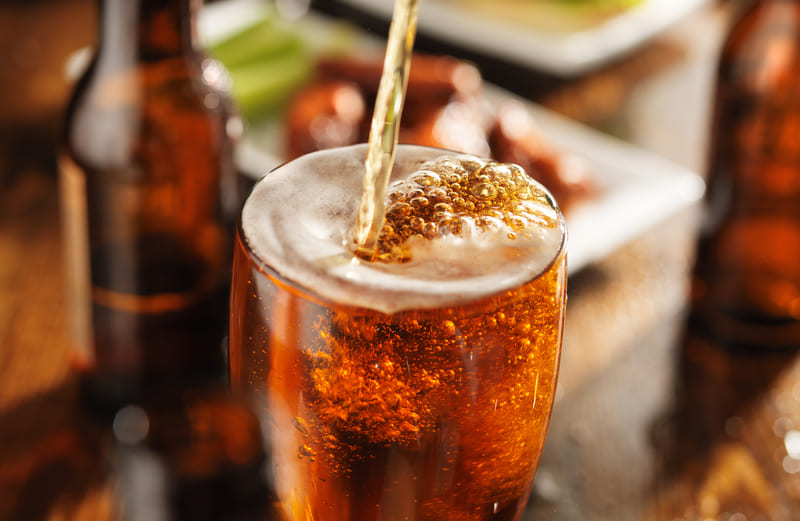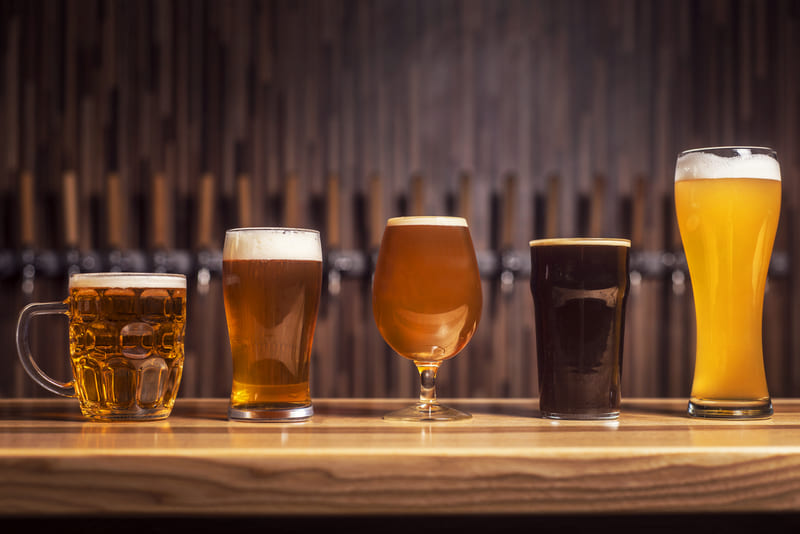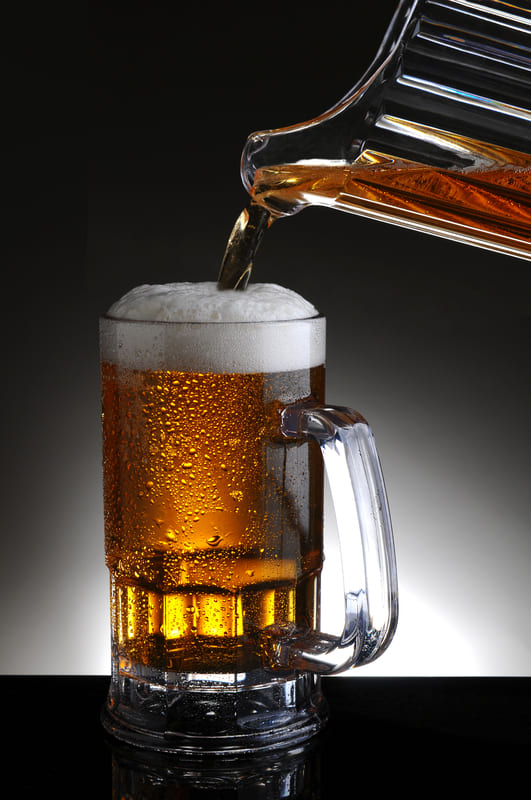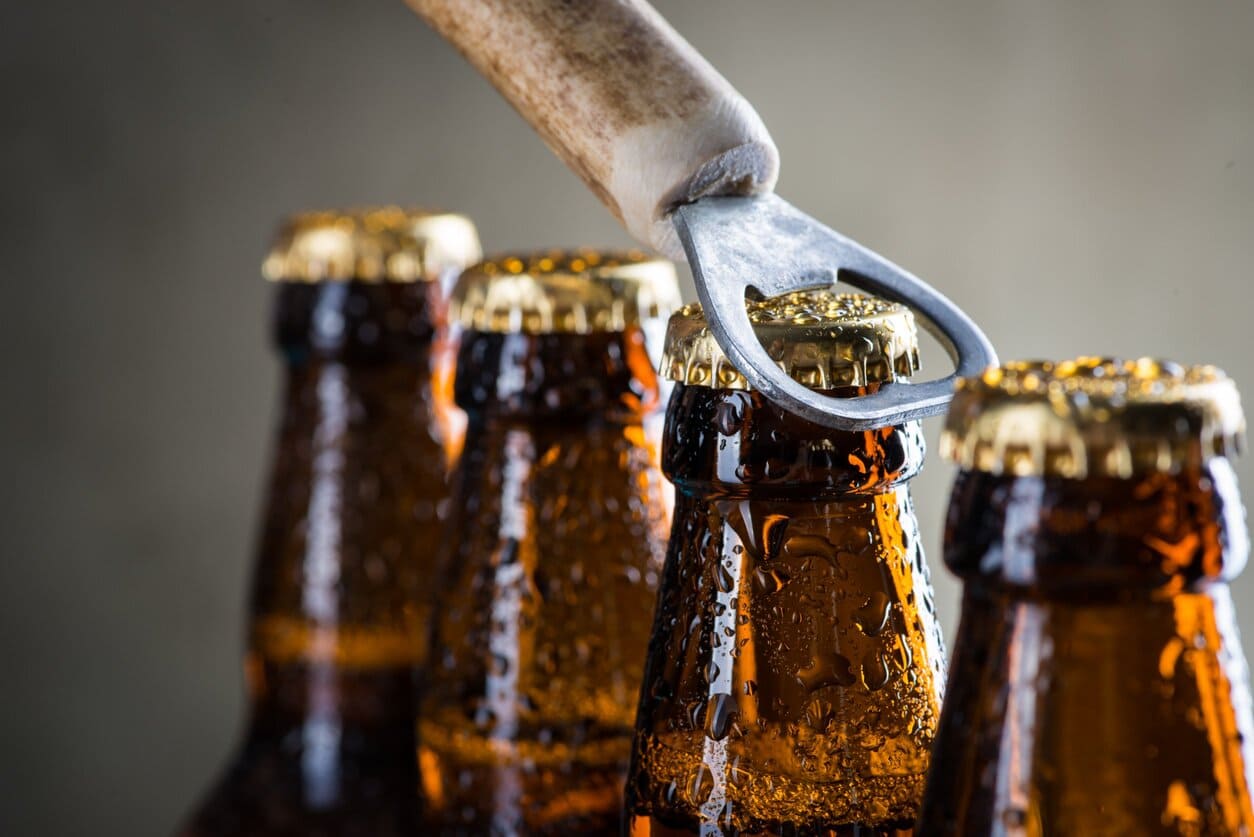One of the most consumed alcoholic drinks in the world, beer is usually made of cereal grains like wheat, malted barley, corn, oats, and rice.
Nowadays, there’s a wide range of beer types on the market. They’re categorized by ingredients, origin, colors, strength, flavor, recipe, and production method.
Pilsner, APAs, porter, IPAs, wheat beers, stout, smoked, and fruit beers are a few of the large palettes you can choose from and enjoy a good beer.
Moreover, all alcoholic beverages have a certain ABV, which you can easily find on the bottle’s labels and see how much alcohol they contain.
The ABV for beers ranges from 3-13%; most beers have 4-7% ABV.
The number of beers you need to drink to get drunk depends on factors such as gender, type of beers, ABV, age, weight, medications used, alcohol tolerance, etc.
So, there’s no exact answer to this question; alcohol’s impact on people’s bodies differs from person to person. Now, let’s discuss this topic in detail and learn more about beers and responsible drinking.
So, How Many Beers to Get Drunk:
One can easily get drunk after only two beers, while another can drink more than five beers without getting drunk.
For instance, if you’re an average man and you’re drinking beer with 5% ABV in one hour, you will need from 4- 5 beers to get drunk. In comparison, average women that consume beer with 5% ABV will get drunk after 3-4 beers in an hour.
However, the number of beers that can get you drunk depends on other factors. Let’s discuss some of these factors to answer this question easily.
ABV
ABV-alcohol by volume is the amount of alcohol beer and other alcoholic drinks contain. Beers can have different amounts of alcohol.
The higher the ABV faster you will get drunk with fewer beers drunk.
For beers, ABV ranges from 3-13%. However, there are also types of beer that contain 20% ABV or more. How many beers will make you drunk also depends on the type of beer you’re drinking.
Usually, craft beers are produced with a higher ABV than mass-produced beers.
The opinion that dark beers have a higher ABV than light types of beers isn’t true. The color of the beer has nothing to do with its alcohol content. There are light beers with high ABV and dark beers with low ABV.
Therefore, the ABV doesn’t depend on the color of the beer. It depends on the type of beer, the brewer, and the brewing process. Light and dark beers have different flavors. So if you want a light, flat flavor beer, you can drink light beer.
If you prefer a beer with an intense flavor that will leave an aftertaste in your mouth, the dark types of beer are the ones you should drink.
Different Types of Beer and Alcohol Content
| Type of Beer | ABV |
| Low alcohol beer | 0.96% |
| English pale ale | 4.71% |
| Lager | 4.5%-5% |
| Hybrid | 4.5%-5% |
| Ipa ale | 6%-8% |
Alcohol Content in Beer
| Brand | ABV |
| Cherry stout | 8.0% |
| Blonde bock | 7.0% |
| Dragon stout | 6.8% |
| Bud ice | 5.5% |
| Carlsberg | 5% |
| Budweiser | 5% |
| Corona | 4.8% |
| Amstel light | 3.5% |
| Heineken light | 3.5% |
Also check out list of 15 Strongest Beers
Age and Gender
Age and gender also affect how many beers you drink to get drunk. Younger people have a faster metabolism, more muscle mass, and higher alcohol tolerance than older people. Therefore, older people will get drunk faster than younger people with fewer beers.
As for the gender, men are bigger than women and have a bigger blood volume, meaning if they both drink the same amount of beer, women will get drunk faster than men.
The reasons for this are the differences between men’s and women’s bodies in metabolism, hormones, and body structure.
A woman’s body contains 52% water and can dilute less alcohol than a man’s body, which has 61% water. That is why women can get drunk faster and with fewer beers than men.
Related: How Many Shots Equal a Beer?
Weight and Height
Weight and height affect the number of beers that can get you drunk.
A person that weighs more has a higher amount of water in their body and will get drunk slower, as the alcohol in their body is diluted more than in someone with a lower body weight.
However, that doesn’t mean that two people of the same weight will get drunk with the same amount of beer because they can have different body fat percentages and muscle mass.
The one with a higher body fat percentage is less tolerant of alcohol and will get drunk faster than the one with a lower fat percentage. At the same time, the person with less muscle mass will get drunk easier than the one with more muscle mass.
A person’s height also affects how many beers they can drink to get drunk. Taller people have a longer circulatory system and higher blood content than shorter people. Therefore, the beer will be distributed slower in their bloodstream, and they will get drunk slower than the shorter people.
Depending on the gender and weight, here are tables that will help you calculate the blood alcohol concentration (BAC) in your body after you have drunk 2-3 or more 12 oz beers with 5% ABV.
You’re legally intoxicated if your BAC is 0.08% in the US.
Water Intake
Water intake during drinking beer can also help you not to get drunk after just 2-3 beers. You can drink water between each beer to help you with dehydration and hangover.
The water will dilute the beer and slow its absorption in your bloodstream, and your liver will also need more time to process it.
Food Intake
Food intake can also slow down the absorption of alcohol into your bloodstream.
Depending on the amount of beer consumed, if you drink on an empty stomach, you will get drunk after ½ -2 hours of drinking.
You will need between 1-6 hours to get drunk if you have eaten. Therefore, avoid drinking on an empty stomach because you will get drunk in no time.
Always eat before or during drinking beer to slow down its absorption in your bloodstream and delay getting drunk.
Time
The liver can metabolize one regular drink or 12 fl oz of regular beer with 5% ABV per hour. But this time frame increases with each beer you drink.
Your blood alcohol content will rise with each beer consumed, and your liver will need more time to process the alcohol.
If you drink more than two regular beers per hour, your liver will be unable to process the alcohol, and unprocessed, it will enter your bloodstream and organs and affect your heart and brain, making you drunk.
To avoid this, try to drink one beer per hour to give time to your liver to process the alcohol. The liver processes more than 90% of the alcohol you drink; the rest of the consumed alcohol is eliminated through sweat, urine, and breathing.
Medical Condition
Your medical condition also affects the number of beers that can make you drunk.
People with chronic diseases will get drunk faster than healthy people, as their bodies and immune system are already weak.
Therefore, if you have some chronic illness, you’re sick, or you have been ill, and now you’re recovering, it’s better not to consume beer or other alcoholic beverages.
Some people have alcohol intolerance and can’t drink any alcoholic beverages.
Medications and Drug Intake
Medication and drugs used with beer or any other alcoholic beverage aren’t a good combination, especially if you use sleeping pills and antidepressants.
Drinking alcohol, in this case, beer, and using these pills can affect your coordination, motor skills, and judgment. You can also feel sleepy and unable to drive, work or do any other physical activity.
Taking medication or drugs and drinking alcohol long-term can damage your internal organs and cause liver damage, internal bleeding, heart problems, depression, and breathing difficulties.
Drinking alcohol and taking painkillers can easily damage your liver, while a combination of alcohol and aspirin can increase the risk of internal bleeding.
Therefore, if you’re using some medication or drugs, always consult a doctor before drinking beer or any other type of alcohol. Or even better, don’t drink alcohol when using medications or drugs.
Sleep Regimen
Sleep regimen affects how fast you will get drunk drinking beer. Some studies found a link between sleep regimen and alcohol tolerance. They claim you’re more tolerant to alcohol if you have slept enough before consuming it.
If you’re sleep deprived for 1-2 or more days, you will get drunk faster, as lack of sleep affects your body the same as drinking alcohol does.
The latest studies found that if you haven’t slept for 17 hours, your body will act similarly to when your BAC (blood alcohol concentration) is 0.05%, while after 24 hours without sleep, your body will be in the same state as if your BAC is 0.1%.
The conclusion is that people who’re sleep deprived, tired, and exhausted will get drunk faster and with fewer beers than those who have slept normally. So, if you haven’t slept enough the previous night, don’t drink because you will get drunk faster.
Alcohol Tolerance
Not all people have the same alcohol tolerance. Those who consume alcohol daily are heavy drinkers and have a higher alcohol tolerance than the ones who drink rarely.
Their brain is used to high doses of alcohol, so they will not display significant signs of intoxication, such as talking incomprehensibly and getting out of balance.
Regular alcohol consumption can increase your tolerance; your brain will memorize and learn how to respond to high amounts of alcohol in your blood.
However, you don’t want to have a high alcohol tolerance, as those people are usually chronic drinkers with alcohol dependency.
Alcohol Units
Alcohol units measure the pure alcohol volume in different alcoholic drinks. In the UK, one unit of alcohol is defined as 10 ml or 8 gr of pure alcohol.
Depending on the alcohol’s volume and its strength, the alcohol units can vary. Usually, alcoholic drinks contain from one to three units of alcohol.
So, a half pint of beer with 3.5% ABV has one alcohol unit. While a stronger beer that contains 6-12% ABV has two alcohol units.
You can easily calculate the alcohol units in your drink with this formula.
Alcohol by Volume (ABV) x Volume (ml) :1,000 = Number of Alcohol Units
For example, if your beverage has 4% ABV and a 3.5 liter or 120 ounces volume, it will have 1.4 alcohol units. But if your beer is stronger and has 5% ABV, it will have 1.8 alcohol units.
If your beer is stronger and you drink more than one beer per hour, you will get drunk faster because your body will not have time to process the alcohol.
Can You Get Drunk on Alcohol-Free Beer?
You can’t get drunk on alcohol-free beer if you’re a healthy adult, so you can drink these beers if you don’t want to get drunk.
They contain alcohol like alcoholic beers but in a smaller percentage.
In fact, in the US, if a brewery produces alcohol-free beers, they should have less than 0.05% ABV.
Lastly, depending on the alcohol they contain, there are four categories of beer:
- Alcoholic beers: more than 1.2% ABV
- Low-alcoholic beers: from 0.5 – 1.2% ABV
- Dealcoholized beers: less than 0.5% ABV
- Non-alcoholic beers: less than 0.05% ABV
Non–alcoholic beer, also known as alcohol-free beer, contains alcohol as a result of the chemical reaction of the yeast.
Brewers have methods to lower the alcohol percentage using filters to separate and reduce or eliminate the alcohol. Some brewers are reducing the alcohol content of the beer using the boiling process.
Therefore, alcohol-free beer contains less alcohol than kefir, boza, rye bread, kvass, or a piece of rum cake, and it can’t get you drunk.
Nowadays, the quality and taste of alcohol-free beers are improved. They’re usually consumed by people who don’t drink alcohol but like how a beer tastes.
The reason why you can’t get drunk with alcohol-free beer is that it has a very low ABV, and your body is metabolizing the alcohol faster than you’re drinking.
Alcohol-free beer will offer you great taste but will not make you drunk.
More: How Many Ounce in a Pitcher of Beer?
Responsible Drinking Limits
Usually, drinking beer is enjoyable, but you can consume more than you can handle and get drunk. Luckily, you can make better choices and prevent that if you take some of the recommended steps and avoid getting drunk.
When Does Drinking Beer Become Dangerous?
Moderately drinking refers to a man who drinks two or fewer beers daily and a woman who drinks one or less daily.
Most people who drink moderately don’t get drunk because they often know how to control themselves and drink only 1-2 beers daily.
However, that isn’t the case with chronic or binge drinking, which is risky and can lead to unwanted problems.
Excessive drinking includes binge drinking, heavy drinking, pregnant drinking, underage drinking, and alcohol use disorder.
- Binge drinking: Defined as four or more beers in about two hours for women and five or more beers in about two hours for men.
- Heavy drinking: Refers to men who drink 15 or more beers a week. For women, this limits eight or more beers a week.
- Pregnant drinking: Alcohol use by pregnant women.
- Underage drinking: Alcohol use by persons under the age of 21.
- Alcohol use disorder: A medical condition when a person can’t stop or control alcohol consumption despite all the negative effects.
How to Not Get Drunk Fast When Drinking Beer?
First, don’t drink beer while hungry. Otherwise, the alcohol will be absorbed much faster in your bloodstream, and you will get drunk more quickly.
Always eat before drinking beer or eat a meal or snacks while drinking.
Second, drink your beer slowly. Drinking one beer per hour is best to give your liver time to metabolize the alcohol.
If you drink two or more beers in an hour, your liver can’t process the alcohol. The unprocessed alcohol will then enter your bloodstream and organs, and affect your heart and brain, making you drunk.
Third, stay hydrated. Before you drink beer, make sure that you’re hydrated to dilute the beer and slow down the absorption of the alcohol in your bloodstream.
You can also drink water between each beer. That way, you will get drunk slower.
Lastly, avoid drinking too many beers and get drunk. Know your limits because getting drunk can lead to many other unwanted situations.
Final Tips
Drinking 1-2 beers a night with your friends or loved ones is fun but getting drunk isn’t. You will feel dizzy, disoriented, lose balance, vomit, and do many other unwanted and bad things.
To avoid this, you have to drink responsibly and don’t endanger your and other people’s lives. To sum up, if you’re an average man and you’re drinking beer with 5% ABV in one hour, you will need from 4- 5 beers to get drunk.
In comparison, average women that consume beer with 5% ABV will get drunk after 3-4 beers in an hour.




